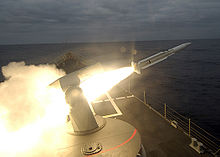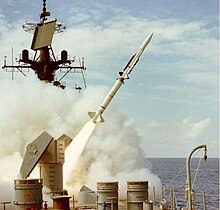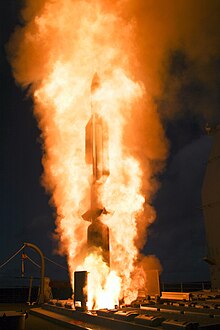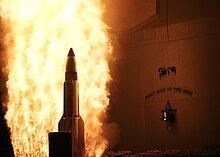Standard Missile

The term standard missile refers to a family of medium to long range surface-to-air missiles . The first producer was General Dynamics , but most variants were developed by the Standard Missile Cooperation, a joint venture between Hughes and Raytheon . After taking over the Hughes Group, Raytheon is now the sole producer. More than 21,000 standard guided missiles had been manufactured by 2001 .
development
The SM-1 was developed to replace the Terrier and Tartar missiles that were used on a large number of US Navy ships in the 1950s. It was used in the Vietnam War. The SM-1 had the same fuselage as its predecessor, the Tartar, so that it could be used more easily with the launchers and magazines that were already there. The SM-2, also known as the Standard Missile 2, was developed in the 1970s and is part of the Aegis combat system and the New Threat Upgrade (NTU). An important decision in the early 1980s was being able to launch the rocket vertically. Both the SM-1 and SM-2 have been continuously developed. However, all variants are semi-active target-seeking , which is why a fire control radar must illuminate the target on the final approach. In order to get around the problem, a " Fire-and-Forget " version has been offered since 2011 with the SM-6 .
Certain versions of the Standard Missile were used as the basis for the Terminal High Altitude Area Defense System (THAAD). Two systems were originally developed, the so-called Navy Area and Navy Theater-Wide. The development of the Navy Area System was stopped by the US Department of Defense due to time delays and a cost explosion . The Navy Theater-Wide system continues under a different name as part of the Missile Defense Agency system family . The missile intended for this is called the SM-3 or Standard Missile 3.
A variant against land targets, the so-called Land Attack Standard Missile SM-4, was stopped before series production. This means that there is still a gap between the firepower and range of ship artillery and cruise missiles such as the BGM-109 Tomahawk .
Standard Missile 1 (SM-1)
The Standard Missile 1 was designed to replace the Tartar guided missile. Therefore, the missile is also to Mk-13-starter and the AN / SPG-51 - fire control radar of Tartar system compatible . There are also some variants that have a greater range thanks to an additional booster ("Extended Range", ER). Furthermore, the rocket has a mode for combating surface targets. However, the warhead is considerably smaller in comparison to "full-fledged" anti-ship missiles , so that this mode was mainly designed to combat smaller ships. The SM-1 was produced from 1967 to 1983. It has since been completely replaced by the SM-2 in the US Navy. Even so, the rocket is still in active service in many states, so the current manufacturer Raytheon is still providing support and spare parts.
variants
-
RIM-66A
- Block I: The first series variant. The Mk 27 dual-thrust rocket engine and the Mk 51 (62 kg) warhead of the Tartar guided missile are used.
- Block II and III: Small improvements to the details have been made.
- Block IV: This is the most commonly produced variant. The following improvements have been achieved: reduced minimum range, increased ECCM capacities and a shorter activation time. The missile entered service in 1968, with many Block III guided missiles being upgraded to this standard.
- RIM-66B , Block V: A new seeker head and autopilot were introduced in this version. A Mk-90 warhead and a Mk-56 rocket engine are also now used. These measures enabled the range to be increased by around 45%.
- RIM-66E , Block VI: This variant received a new Mk-45 proximity fuse and a monopulse radar seeker head, which improved the performance against targets with a small radar cross-section .
- RIM-67A: This is the ER variant (Extended Range) with increased range. With the exception of the drive system, it does not differ from the other RIM-66 versions. In addition to another rocket engine (Mk 30), an additional booster (Mk 12) was installed to increase the range.
- RGM-66D: This variant is specially designed for use as an anti-ship missile. It is based on the RIM-66B, using a fully passive radar seeker. This allows the missile to target enemy ship radars.
- RGM-66E: Corresponds to the D version, but was used from ASROC starters.
- RGM-66F: This version should have an active radar seeker for anti-ship combat . The development was stopped in 1975 after a few tests.
Standard Missile 2 (SM-2)

The SM-2 emerged from the US Navy’s request for a new guided missile that had a significantly higher range and immunity to interference than the SM-1, but at the same time should be compatible with as many components of the old system as possible. Therefore, the SM-2 can also be used with the old Mk-13 starter and the AN / SPG-51 - and - 60 - fire control radar . This missile is the central part of the Aegis-fighting system and was from the outset for use in combination with the AN / SPY-1 - search radar and the AN / SPG-62 provided -Feuerleitradar. Therefore, the new seeker does not require continuous radar illumination of the target like the SM-1. When starting, the inertial navigation system receives the position of the target object from the ship's fire control system. After take-off, the SM-2 can now cover most of the way autonomously with the help of its navigation system, so that radar lighting of the target is only necessary in the final phase of the flight. Like the SM-1, the SM-2 also has an anti-ship mode, which was also used during Operation Praying Mantis to sink the Iranian patrol boat Joshan . In its anti-aircraft role, the missile was used only once. Tragically, it was used to shoot down Iran Air Flight 655 , which was mistakenly identified as an Iranian F-14 Tomcat during Operation Earnest Will . The SM-2 family also has variants with an increased range ("Extended Range"; ER).
variants
- RIM-66C , Block I: This is the first production variant with a Mk 115 warhead, a monopulse radar seeker and a new autopilot. It entered service in 1978 and was produced until 1983.
- RIM-66D , Block I: Similar to the C variant, but adapted for use on ships with Tartar fire control systems.
- RIM-66G , Block II: An improved Mk-104 rocket engine was installed to increase performance against fast and agile targets. In addition, new signal processors have been integrated to increase the ECCM capacities. A new proximity fuse and a warhead with a directed explosive effect ensure a higher probability of firing. This version is designed for use on Aegis ships and entered service in 1983.
- RIM-66H , Block II: The G variant for starting from a VLS system Mk 41.
- RIM-66J , Block II: G variant for ships with a Tartar fire control system.
- RIM-66K , Block IIIA: In this version, the aiming system has been revised to ensure better performance against low-flying targets. The new Mk-115 warhead was also used. This missile is based on the Tartar fire control system.
- RIM-66L , Block IIIA: Similar to the K version, but designed for use by the Aegis combat system.
- RIM-66M , Block IIIB: This variant is characterized by an additional infrared search head. This was developed as part of the Missile Homing Improvement Program (HMIP) in order to be able to effectively combat the latest aircraft and anti-ship missiles under the influence of massive radar interference. This variant was procured in large numbers and is tailored to the Mk 41 VLS system. Raytheon has been providing a so-called "maneuverability upgrade" since the beginning of 2007, which significantly increases the rocket's maneuverability through new software and thrust vector control . The upgrade can easily be installed in existing Block III-B guided missiles. Currently (as of January 2009) an improved target acquisition system is also being tested.
- RIM-67B , Block I: This is the "Extended Range" variant (ER) with increased range. As with the SM-1 ER, this is achieved using an additional booster. This version was introduced in 1980.
- RIM-67C , Block II: By using the new Mk-70 booster, the range could be massively increased again.
- RIM-67D , Block III: This variant got a new rocket engine and an improved aiming system, similar to that of the RIM-66K.
- RIM-67E: Incorrect name for the RIM-156A
- RIM-156A , Block IV: The Block IV version is designed to provide better defense against high-flying targets at long range, the latest anti-ship missiles and targets with small radar cross- sections. The missile also has improved ECCM capabilities. The block IV variant was also planned as an intermediate step in the development of the block IVA variant, which is why only relatively small numbers were procured. Thanks to a completely newly developed booster (no wings, thrust vector control ), use with the Mk 41 VLS system was now also possible. The missile entered service in 1999 and is currently (February 2008) the most far-reaching conventional anti-aircraft guided missile.
- RIM-156B , Block IVA: This variant was intended to enable effective combat against ballistic missiles as part of the Navy Area TBMD program . Despite a successful test, the program and with it the development of this variant was discontinued in December 2001. The SM-3 missile takes over its task.
- NT-SBT: When the development of the block IVA variant was discontinued, a different solution was sought in order to be able to fight ballistic missiles within the earth's atmosphere . The block IV variant should serve as the basis. The resulting missile is called the Near Term Sea-Based Terminal Weapon (NT-SBT), sometimes also referred to as “modified SM-2 Block IV”, and is primarily intended to defend against short-range ballistic missiles in their final phase . Compared to the Block IV variant, u. a. the control software , the booster and the thrust vector control modernized. In April 2006 the missile was successfully used against a subsonic test target, in May of the same year a short-range missile of the type MGM-52 Lance was successfully intercepted and in June 2007 the first missile from series production was handed over to the US Navy . On June 5, 2008, during a test, the guided missile successfully intercepted a short-range missile as it reentered at a height of 19 km. On March 26, 2009, a short-range missile was intercepted with an NT-SBT, while a RIM-66L shot down a cruise missile in parallel.
Standard Missile 3 (SM-3)
After the development of the SM-2 Block IVA was discontinued, the development of the Standard Missile 3 for intercepting ballistic missiles began as part of the US missile defense program . The destruction of approaching missiles takes place with the help of a kinetic warhead (also called " kinetic warhead " or " kill vehicle "), which hits the target directly outside the atmosphere and destroys it with its high kinetic energy . So there is no need for explosives as with conventional warheads . The interception course is determined by means of a FLIR sensor that locks onto the target. The warhead then uses thrusters to set itself on a collision course with the target object in order to destroy it. The collision with the target object takes place at a speed of over 8 km / s (28,800 km / h). The SM-3 can also carry a multiple kill vehicle system.
The development is led by the Missile Defense Agency , which was established as part of this defense program. 18 ships (three guided missile cruisers, 15 guided missile destroyers) of the Navy were equipped with it in 2010. By January 2010, the SM-3 was able to successfully intercept 18 targets in 20 tests, which corresponds to a hit probability of 90%. In a test, two ballistic missiles were intercepted simultaneously, with a Japanese Kongō- class destroyer also tracking the target and performing a simulated combat. On December 17, 2007, the Japanese ship Kongō was able to autonomously intercept a medium-range ballistic missile launched from the island of Kaua'i at a height of 160 km. The maneuver was followed by Lake Erie , with the ship continuously exchanging target data with a THAAD system. The kinetic warhead itself has proven itself another six times in additional tests.
Also, Japan is planning to introduce the SM-3 interceptor missiles on destroyers of the Japanese Self-Defense Forces to protect against possible North Korean missile. Therefore, one is involved in the system development with several billion US dollars.
The SM-3 missile has limited capabilities as an anti-satellite weapon . The runaway spy satellite USA 193 (NRO-L 21) was successfully destroyed on February 21, 2008 by an SM-3 missile in a launch area north of Hawaii . The satellite was hit directly at an altitude of 150 miles at a speed of 10.5 km / s. The rocket was launched from the USS Lake Erie, with the USS Decatur and the USS Russell belonging to the task force. The start was significantly delayed by the fact that the satellite tumbled uncontrollably and therefore no precise orbit data could be determined before the launch. The following tracking and tracking systems were used during the operation: Sea-Based X-Band Radar , PAVE PAWS , BMEWS , AN / SPY-1B / D , THAAD radar systems, test radars from the Kauai Test Facility and various satellite-based systems.
In February 2008, Raytheon received an order from the US Department of Defense to deliver 102 SM-3 Block IA guided missiles by early 2012. 75 should go to the US Navy and 27 to Japan.
The Missile Defense Agency also considered a land-based version of the SM-3 as Israel is looking for ways to combat Iranian medium-range missiles outside of the Earth's atmosphere. Raytheon was working on a limited mobile system with eight VLS modules that are also used on Aegis ships. The missile itself only needs to be modified slightly; however, extensive changes to the C2 system would be necessary in order to integrate it into the Israeli communications network.
Test results

As of September 2012
| date | Target type | Range of the target | Separating warhead |
platform | Test result |
|---|---|---|---|---|---|
| January 2002 | SRBM | 300-500 km | No | USS Lake Erie | success |
| January 2002 | SRBM | 300-500 km | No | USS Lake Erie | success |
| November 2002 | SRBM | 160-600 km | No | USS Lake Erie | success |
| June 2003 | SRBM | 160-600 km | No | USS Lake Erie | Failure |
| December 2003 | SRBM | 160-600 km | No | USS Lake Erie | success |
| February 2005 | SRBM | 160-600 km | No | USS Lake Erie | success |
| November 2005 | MRBM | 227-925 km | Yes | USS Lake Erie | success |
| June 2006 | MRBM | 227-925 km | Yes | USS Shiloh | success |
| December 2006 | SRBM | 400 km | No | USS Lake Erie | Failure |
| April 2007 | SRBM | 400 km | No | USS Lake Erie | success |
| June 2007 | MRBM | 227-900 km | Yes | USS Decatur | success |
| August 2007 | secret | secret | secret | secret | success |
| November 2007 | 2 × SRBM | 400 km | No |
Lake Erie , Kongo |
2 × success |
| December 2007 | MRBM | 227-900 km | Yes | JDS Kongō | success |
| February 2008 * | Satellite ( USA 193 ) |
- | - | USS Lake Erie | Success* |
| November 2008 | 2 × SRBM | unbk. | unbk. |
USS Hopper , USS Paul Hamilton |
1 × failure 1 × success |
| July 2009 | SRBM | unbk. | unbk. | USS Hopper | success |
| October 2009 | MRBM | unbk. | Yes | JDS Myoko | success |
| October 2010 | MRBM | 1000 km | Yes | JDS Kirishima | success |
| April 2011 | IRBM | 2,400-5,500 km | Yes | USS O'Kane | success |
| September 2012 | unbk. | unbk. | unbk. | USS Lake Erie | Failure |
| May 2012 | unbk. | unbk. | unbk. | USS Lake Erie | success |
| June 2012 | unbk. | unbk. | Yes | USS Lake Erie | success |
* Extraordinary use
variants
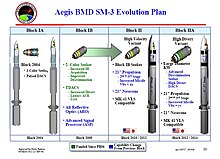
Since 2004 the Ministry of Defense has been planning a steady improvement of the SM-3. This is to take place in several steps ("blocks"), with development beginning in 2007. The following is an overview of the planned variants.
- RIM-161A , Block I: A series of prototypes based on the RIM-156A. Eleven missiles were procured.
- RIM-161B , Block IA: Designates the version that has been used in tests since 2004 and uses a monoband FLIR sensor. 82 guided weapons were to be procured.
- RIM-161C , Block IB: In this variant, the kinetic warhead has been improved. A dual-band FLIR sensor was integrated for this purpose, which can evaluate two frequency bands at the same time. Together with a new on-board computer, this increases the interception performance, especially in the vicinity of disruptive measures and decoys. In addition, further improvements were made to the optics in order to ensure a higher detection range. In addition, a new propulsion system was developed that can control the thrusters more precisely and thus ensure more precise course control. The first test launch took place from the USS Lake Erie in May 2012. The launch took place in April 2014, a total of 52 missiles should be procured.
- Block II: In addition to other small modifications to the warhead, this variant focuses on improving flight characteristics. The entire rocket is to be increased in diameter to 53 cm, so that the available space in a Mk-41 VLS system can be fully utilized. This means that significantly more fuel can be carried, which makes fighting ICBMs easier. Even Japan wanted to participate in the development of this variant, which should have been implemented between 2010 and 2012..
- Block IIA: This further development of the SM-3 would include a larger kinetic warhead with even better immunity to interference and maneuverability. The first test start took place in June 2015 and at that time the introduction was planned for 2018, with Japan also participating in this version.
- Block IIB: Projected SM-3 version using only the sensor package of the previous models. The aim of the newly developed missile would be to combat ICBM during the start phase (English boost phase) at an altitude of 20 to 40 km. The Aegis ships serve primarily as the operational platform.
Standard Missile 4 (LASM)
The SM-4 was designed as a land target missile and was designated as the RGM-165 LASM (Land Attack Standard Missile). For this purpose, the radar seeker was replaced by a GPS / INS seeker and the warhead by a Mark 125 of the SM-2MR Block IIIA with 135 kg. Otherwise it was identical to the SM-2MR. The range in ship-to-ground use was 280 km. This should provide ground troops on land from the sea with fire support if a BGM-109 Tomahawk were oversized. The LASM would have plunged into the target and detonated just above the ground to increase its effectiveness. After the new viewfinder had been tested on three modified RIM-66K SM-2MR Block III at the end of 1997, LASM development began and the designation RGM-165A was assigned. Originally, 800 SM-2MR Block II / III missiles were to be converted into RGM-165A in order to be available from 2003/2004. However, the US Navy ended the program in 2002 on the grounds that the weapon could not successfully attack either moving or hardened targets.
Standard Missile 5
Should create a next-generation anti-aircraft missile. After discussing alternatives, in which more emphasis was placed on costs, the US Navy decided on the incremental procedure model with the SM-6. The Standard Missile 6 is said to have 80 percent of the capabilities of an SM-5 at only half the cost.
Standard Missile 6 (SM-6 ERAM)
The RIM-174 SM-6 ERAM (Extended Range Active Missile) is a further development of the SM-2 missile, which is supposed to improve the combat of the latest combat aircraft and cruise missiles . For this purpose, the active radar seeker head of the AIM-120C-7-AMRAAM missile was adapted so that it can be built into the housing of the Block IV missile SM-2. This step makes it possible to reduce development time and costs considerably and to increase reliability, since most of the components are already mature and only need to be modified slightly. Thanks to the on-board radar, it is now possible to combat targets that are behind the radar horizon of the launch platform. In addition, sea targets and ballistic missiles can also be fought within the atmosphere. Compared to the original AMRAAM seeker head, the diameter of the antenna has been increased from 18 cm to 34 cm in order to increase its performance. In this case, the target data is made available by other sensor platforms - including via the Cooperative Engagement Capability system (e.g. from AWACS machines or combat aircraft). Classic semi-active steering with a target radar is still possible, however. As with the RIM-156A, the range should be over 370 km (200 NM +).
After the project termination of the SM-2ER Block IVA (RIM-156B), Raytheon received the development order for the RIM-174 SM-6 ERAM in 2004. The project started in 2005. The first integration tests were carried out in 2007. On 24 June 2008, the SM-6 was a BQM-74 - target drone successfully shoot. To do this, she used her active radar seeker and scored a direct hit. On May 8, 2009, a cruise missile was successfully intercepted over land. The steering during the cruise was carried out by a pre-production model of the E-2D Hawkeye , which is also under development . Communication was carried out via the CEC data link. The fourth guided flight test took place on January 14, 2010, so that the guided missile could then also be tested at sea.
In 2006 Raytheon received the order to ramp up production of the guided missile by 2011 for pre-series production. In March 2011 the first SM-6 was delivered to the US Navy. Three months later, the company received an order for 182 million US dollars, which provides for the production of 59 additional missiles. In October 2013 an order with a volume of US $ 243 million was placed for a further 89 guided missiles. With the installation of the first guided missiles on the Kidd , operational readiness was achieved on November 27, 2013 , and full operational readiness (FOC) has been in place since the end of April 2017. 330 guided missiles were delivered by April 2017.
Platforms
SM-1
- United States: Oliver Hazard Perry Class , California Class , Virginia Class , USS Truxtun
- Europe: Cassard class (France), Audace class (Italy), De la Penne class (Italy), Tromp class , Jacob van Heemskerck class (Netherlands), class 103 (Germany)
- Japan: Tachikaze class , Hatakaze class
SM-2
Note: All ships that can use SM-2 missiles are compatible with the SM-1 missiles , provided they have an Mk-13 or Mk-26 launcher .
- USA: Ticonderoga Class , Arleigh Burke Class , Belknap Class , Leahy Class , Virginia Class
- Europe: Álvaro de Bazán class (Spain), De Zeven Provinciën class (Netherlands), Saxony class (Germany), Milgem class (Turkey)
- Other: Iroquois- class (Canada), Kongō- class (Japan)
SM-3
- United States: Ticonderoga class , Arleigh Burke class
- Japan: Kongō- class
SM-6
- USA: Arleigh Burke class
Technical specifications
| system | SM-1 medium range | SM-1 Extended Range | SM-2 medium range | SM-2 Extended Range | SM-3 | SM-6 |
|---|---|---|---|---|---|---|
| variant | RIM-66E | RIM-67A | RIM-66M | RIM-156A | RIM-161B | RIM-174 |
| length | 4.41 m | 7.90 m | 4.72 m | 6.55 m | 6.60 m | ~ 6.55 m |
| Takeoff weight | 496 kg | 1,341 kg | 708 kg | 1,466 kg | 1,501 kg | ~ 1,510 kg |
| diameter | 0.34 m | 0.34 m | 0.34 m | 0.53 m | 0.34 m | 0.53 m |
| span | 1.08 m | 1.60 m | 1.08 m | 1.08 m | 1.57 m | 1.57 m |
| drive | single-stage solid rocket | two-stage solid rocket | single-stage solid rocket | two-stage solid rocket | three-stage solid rocket | two-stage solid rocket |
| Range | 45 km | 65 km | 167 km | 185-370 km | 500 km + | 370 km + |
| Bet height | 19 km | 24 km | 24 km + | 33 km | At least 150 miles | 34 km |
| speed | Do 2+ | Do 2+ | Do 3.5 | Do 3.5 | Do 8 | Do 3.5 |
| steering | Semi-active radar target search | Semi-active radar target search, INS | Semi-active radar target search, INS, 2-way data link, IR | Semi-active radar target search, INS, 2-way data link | Data link, GPS , INS, FLIR | Semi-active radar target search, active radar target search, GPS, INS, data link, CEC |
| Warhead | 62 kg continuous rod | 62 kg continuous rod | 113 kg high explosive / splinter | 113 kg high explosive / splinter | Lightweight Exo-Atmospheric Projectile (kinetic warhead) |
Mk 125, 113 kg insensitive / highly explosive / fragment |
| ignition | Impact / proximity fuse | Impact / proximity fuse | Impact / proximity fuse | Impact / proximity fuse | no ignition available | Impact / proximity fuse |
| Starting systems | Mk 13 | Mk 10 | Mk 13 / Mk 26 / Mk 41 | Mk 41 | Mk 41 | Mk 41 |
| Introductory year | 1970 | 1981 | 1981 | 1998 | Testing since 2004 | 2013 |
| Unit price | $ 402,500 | $ 409,000 | 421,400 USD | k. A. | approximately $ 990,000 | k. A. |
Comparable systems
- SA-N-3
- SA-N-6
- SA-N-20
- RIM-162 Evolved Sea Sparrow Missile
- Sea darts
- HQ-9 (Chinese version of the S-300P )
- Aster 15/30
Web links
- SM at Raytheon (English)
- SM-3 at designation-systems.net (English)
- SM series at GlobalSecurity.org (English)
Individual evidence
- ↑ DefenseTech.org (English)
- ↑ Navy Missile Hits Decaying Satellite Over Pacific Ocean.
- ↑ Aviation Week - March 24, 2008 ( Memento from January 17, 2012 in the Internet Archive )
- ↑ a b U.S. Department of Defense
- ↑ Defense Update - June 8, 2015
- ↑ Aviation Week - June 22, 2010
- ↑ Standard Missile-3 Block IIB Analysis of Alternatives. Accessed December 4, 2013
- ↑ Designation Systems: Raytheon RGM-165 LASM. accessed on August 27, 2014
- ↑ Global security: SM-5 Mountain Top. accessed on August 27, 2014
- ↑ a b Standard Missile-6 (SM-6) Moves Ahead. (PDF; 217 kB), accessed on January 10, 2010
- ^ A b Raytheon’s Standard Missile Naval Defense Family. Accessed January 10, 2010
- ↑ a b c Standard Missile SM-6 Achieves Full Operational Capability with US Navy accessed April 30, 2017
- ↑ Standard Missile-6 (SM-6). Accessed September 11, 2014
- ↑ Integrated Live-Fire Test Demonstrates Future Weapons System Capability. Accessed January 10, 2010
- ^ Raytheon - Raytheon Delivers First Standard Missile-6 to US Navy.
- ^ Arizona Daily Star - News & Notes.
- ↑ US Navy Deploys Standard Missile-6 for First Time. Accessed December 4, 2013
- ↑ a b c d e f g h US Navy Fact File , accessed February 14, 2015, as of November 15, 2013
